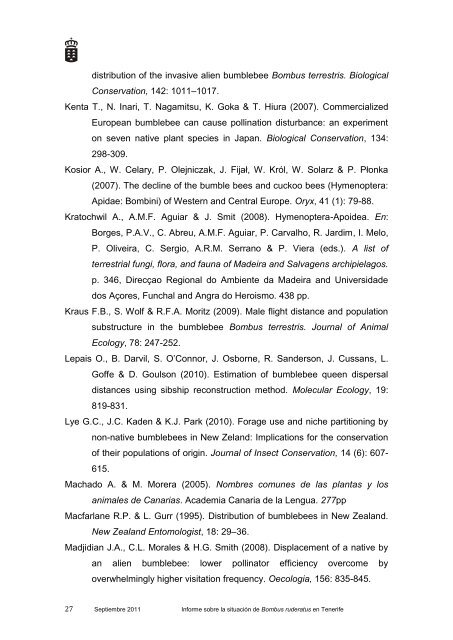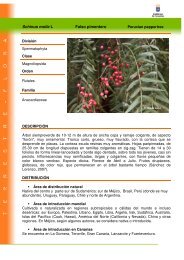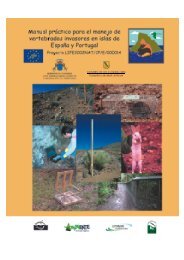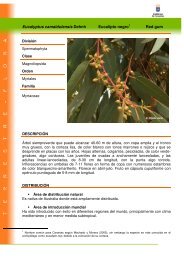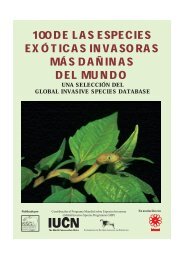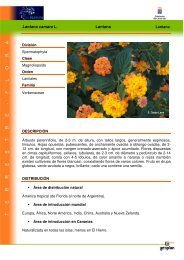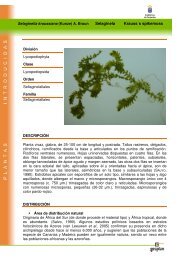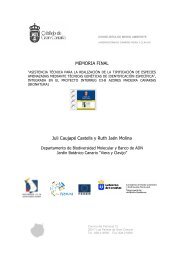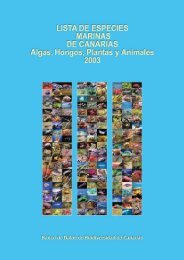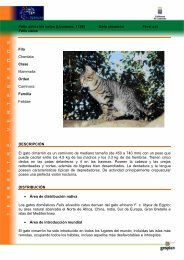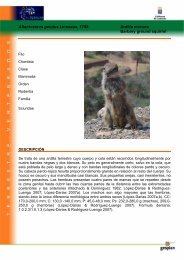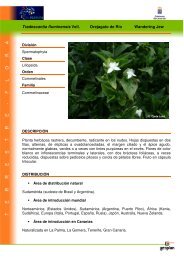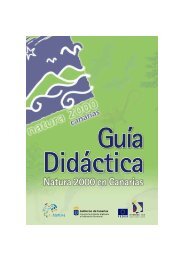Informe sobre la situación de Bombus ruderatus ... - Interreg Bionatura
Informe sobre la situación de Bombus ruderatus ... - Interreg Bionatura
Informe sobre la situación de Bombus ruderatus ... - Interreg Bionatura
You also want an ePaper? Increase the reach of your titles
YUMPU automatically turns print PDFs into web optimized ePapers that Google loves.
distribution of the invasive alien bumblebee <strong>Bombus</strong> terrestris. Biological<br />
Conservation, 142: 1011–1017.<br />
Kenta T., N. Inari, T. Nagamitsu, K. Goka & T. Hiura (2007). Commercialized<br />
European bumblebee can cause pollination disturbance: an experiment<br />
on seven native p<strong>la</strong>nt species in Japan. Biological Conservation, 134:<br />
298-309.<br />
Kosior A., W. Ce<strong>la</strong>ry, P. Olejniczak, J. Fijał, W. Król, W. So<strong>la</strong>rz & P. Płonka<br />
(2007). The <strong>de</strong>cline of the bumble bees and cuckoo bees (Hymenoptera:<br />
Apidae: Bombini) of Western and Central Europe. Oryx, 41 (1): 79-88.<br />
Kratochwil A., A.M.F. Aguiar & J. Smit (2008). Hymenoptera-Apoi<strong>de</strong>a. En:<br />
Borges, P.A.V., C. Abreu, A.M.F. Aguiar, P. Carvalho, R. Jardim, I. Melo,<br />
P. Oliveira, C. Sergio, A.R.M. Serrano & P. Viera (eds.). A list of<br />
terrestrial fungi, flora, and fauna of Ma<strong>de</strong>ira and Salvagens archipie<strong>la</strong>gos.<br />
p. 346, Direcçao Regional do Ambiente da Ma<strong>de</strong>ira and Universida<strong>de</strong><br />
dos Açores, Funchal and Angra do Heroismo. 438 pp.<br />
Kraus F.B., S. Wolf & R.F.A. Moritz (2009). Male flight distance and popu<strong>la</strong>tion<br />
substructure in the bumblebee <strong>Bombus</strong> terrestris. Journal of Animal<br />
Ecology, 78: 247-252.<br />
Lepais O., B. Darvil, S. O’Connor, J. Osborne, R. San<strong>de</strong>rson, J. Cussans, L.<br />
Goffe & D. Goulson (2010). Estimation of bumblebee queen dispersal<br />
distances using sibship reconstruction method. Molecu<strong>la</strong>r Ecology, 19:<br />
819-831.<br />
Lye G.C., J.C. Ka<strong>de</strong>n & K.J. Park (2010). Forage use and niche partitioning by<br />
non-native bumblebees in New Ze<strong>la</strong>nd: Implications for the conservation<br />
of their popu<strong>la</strong>tions of origin. Journal of Insect Conservation, 14 (6): 607-<br />
615.<br />
Machado A. & M. Morera (2005). Nombres comunes <strong>de</strong> <strong>la</strong>s p<strong>la</strong>ntas y los<br />
animales <strong>de</strong> Canarias. Aca<strong>de</strong>mia Canaria <strong>de</strong> <strong>la</strong> Lengua. 277pp<br />
Macfar<strong>la</strong>ne R.P. & L. Gurr (1995). Distribution of bumblebees in New Zea<strong>la</strong>nd.<br />
New Zea<strong>la</strong>nd Entomologist, 18: 29–36.<br />
Madjidian J.A., C.L. Morales & H.G. Smith (2008). Disp<strong>la</strong>cement of a native by<br />
an alien bumblebee: lower pollinator efficiency overcome by<br />
overwhelmingly higher visitation frequency. Oecologia, 156: 835-845.<br />
27 Septiembre 2011 <strong>Informe</strong> <strong>sobre</strong> <strong>la</strong> situación <strong>de</strong> <strong>Bombus</strong> ru<strong>de</strong>ratus en Tenerife


